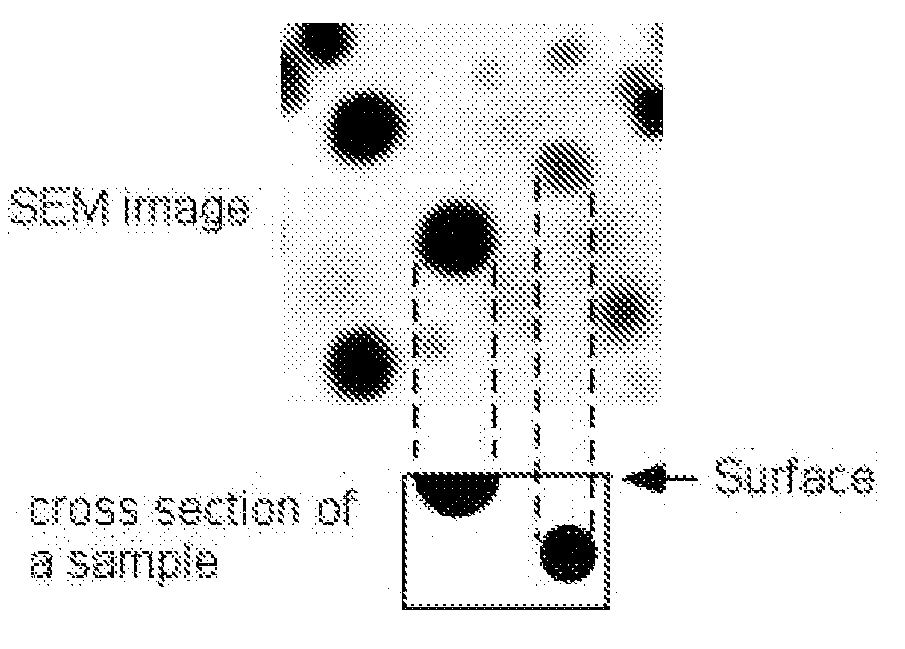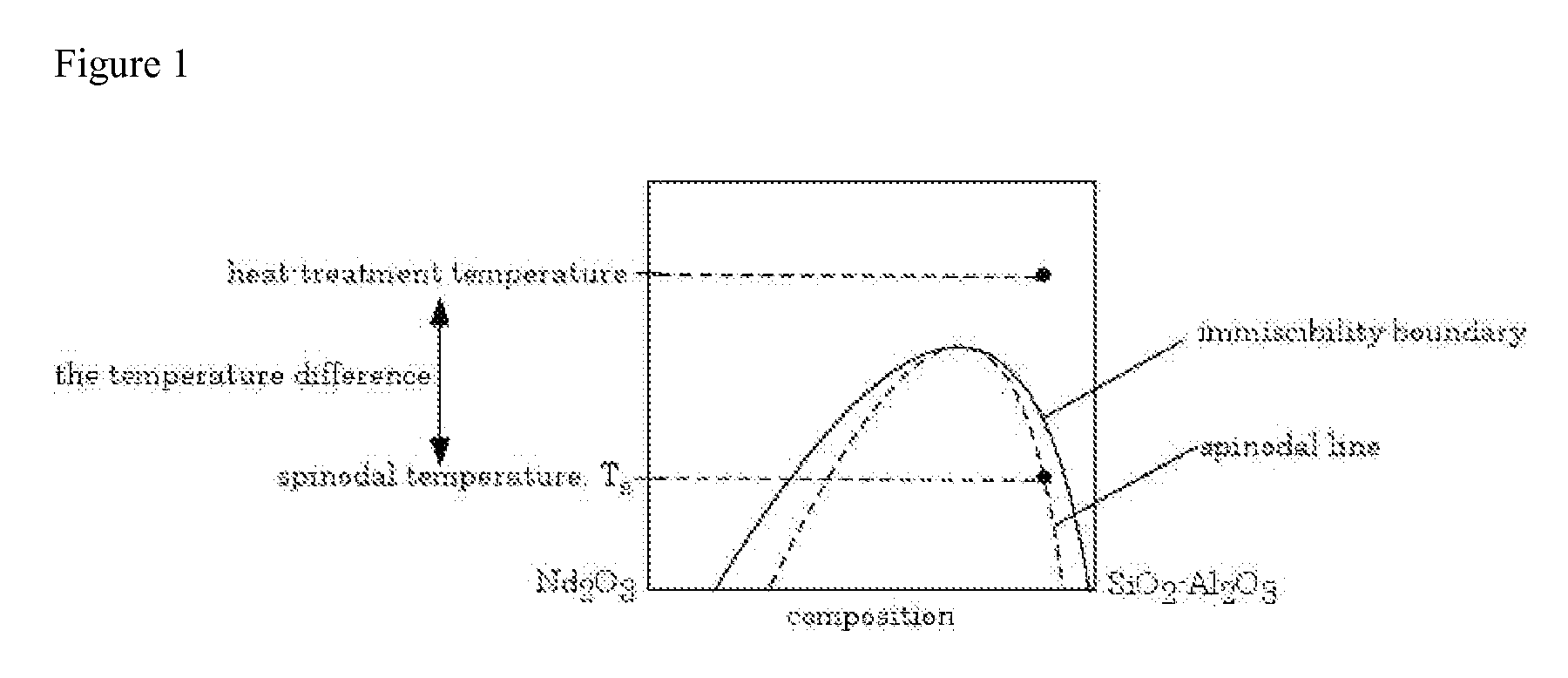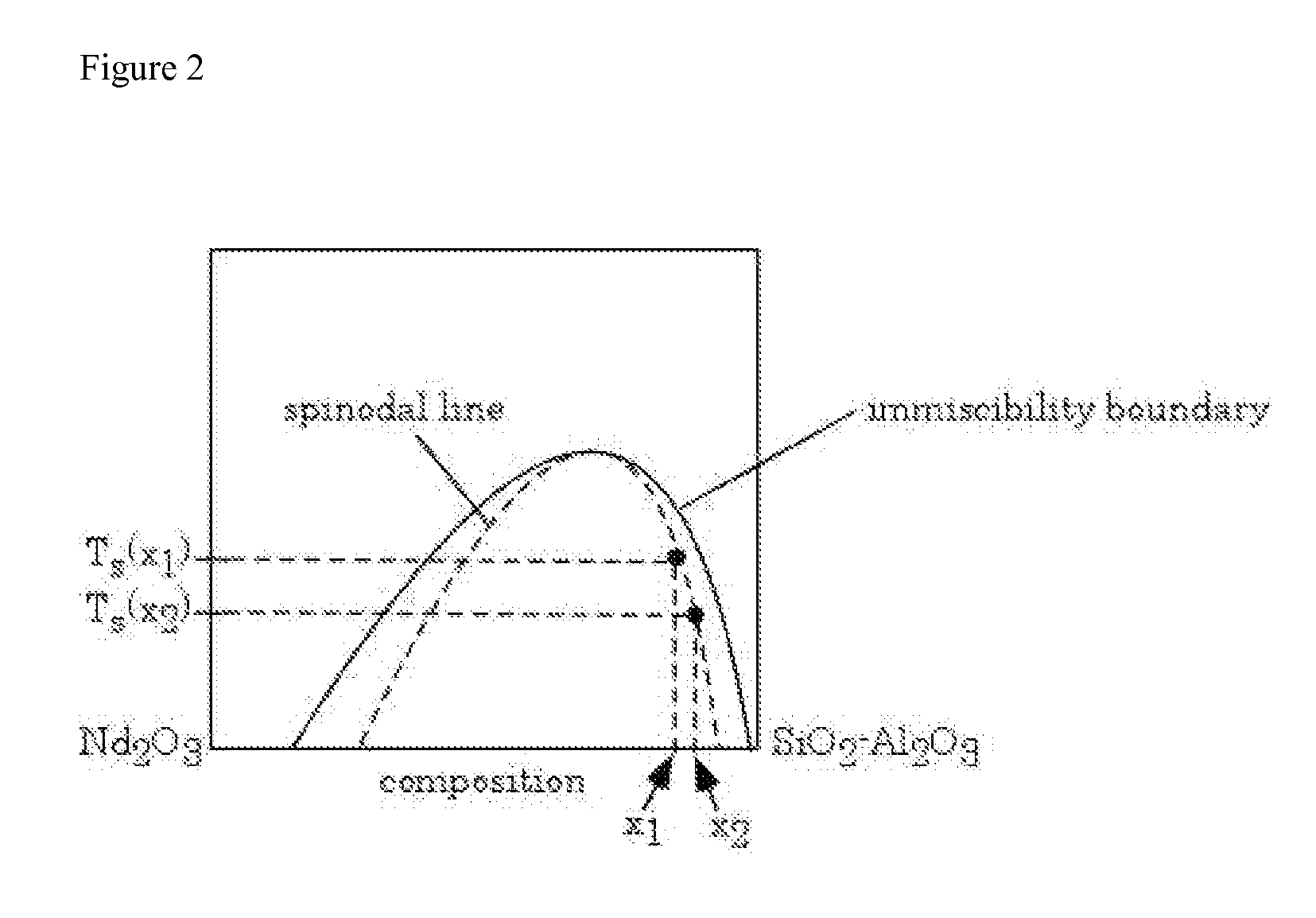Process for making rare earth containing glass
a rare earth and glass technology, applied in glass rolling apparatus, glass tempering apparatus, natural mineral layered products, etc., can solve the problems of low glass optical efficiency, phase separation problems, concentration quenching, etc., and achieve the effect of reducing concentration quenching and low solubility
- Summary
- Abstract
- Description
- Claims
- Application Information
AI Technical Summary
Benefits of technology
Problems solved by technology
Method used
Image
Examples
example 1
Estimating the Spinodal Lines from the Critical Compositions at 1750° C. and 1600° C. for SiO2—Nd2O3—Al2O3 Glass
[0087]A SiO2—Nd2O3—Al2O3 glass was prepared, in accordance with the process of the invention, by melting. Composition ranges of the glasses were Nd2O3 2.5-40 mol %, Al2O3 0-15 mol % with the balance being SiO2. Batch materials used in glass melting were sol-gel-derived high purity silica powder from Nippon Kasei Chemical Co., Ltd. (MKC® silica PS400L), Nd2O3 powder from Sigma-Aldrich (99.9% purity) and reagent-grade Al2O3 powder from Fisher Scientific. The batch was mixed using an alumina mortar and pestle. Approximately 50 mg of the mixture was put in a 90% Pt-10% Rh boat (ca. 10 mm×10 mm×5 mm) and melted for 1 h at 1750° C. in air. The melted glass was quenched by putting it into water together with the boat. Similar glasses were heat-treated also at 1600° C. before water quenching. To prepare these samples, the glass was melted at 1750° C. for 1 h and then cooled down t...
example 2
Relation of the Immiscibility Boundary to the Volume Fraction
[0092]In order to relate the immiscibility boundary to the volume fraction evaluated, the immiscibility boundary has to be expressed in vol %. This was achieved by first converting mol % to wt % and then to vol %. FIG. 8 shows the immiscibility boundary in wt % which was obtained from the immiscibility boundary in mol % shown in FIG. 7 using the formula weight of each oxide. FIG. 9 shows the immiscibility boundary in vol % which was obtained using the density of each oxide. For SiO2, the density of SiO2 glass, 2.20 g / cm3, was used. For the densities of Nd2O3 and Al2O3, the values of Nd2O3 and Al2O3 at room temperature, 7.24 g / cm3 and 3.99 g / cm3, respectively, were used.
[0093]The volume fractions of separated phases of selected glass samples are shown in Table B. The area fractions in the SEM images are equivalent to the volume fractions of the separated two phases in the sample. Here, as explained earlier in connection wit...
example 3
Phase Diagram at 1750° C.: SiO2—Er2O3—Al2O3 Glass
[0098]SiO2—Er2O3—Al2O3 glasses were prepared by melting. Composition ranges of the glasses were Nd2O3 7.5-26.25 mol %, Al2O3 5-15 mol % with the balance SiO2. Batch materials used in glass melting were sol-gel-derived high purity silica powder from Nippon Kasei Chemical Co., Ltd. (MKC® silica PS400L), Er2O3 powder from Sigma-Aldrich (99.99% purity) and reagent-grade Al2O3 powder from Fisher Scientific. The batch was mixed using an alumina mortar and pestle. Approximately, 50 mg of the mixture was put in a 90% Pt-10% Rh boat (ca. 10 mm×10 mm×5 mm) and melted for 1 h at 1750° C. in air. The melted glass was quenched by putting it into water together with the boat.
[0099]FIG. 13 shows the phase diagram determined by the experiment above. The same tendency with regard to immiscibility-miscibility behavior as the SiO2—Nd2O3—Al2O3 glass system of Example 1 was obtained.
PUM
| Property | Measurement | Unit |
|---|---|---|
| mol % | aaaaa | aaaaa |
| mol % | aaaaa | aaaaa |
| mol % | aaaaa | aaaaa |
Abstract
Description
Claims
Application Information
 Login to View More
Login to View More - R&D
- Intellectual Property
- Life Sciences
- Materials
- Tech Scout
- Unparalleled Data Quality
- Higher Quality Content
- 60% Fewer Hallucinations
Browse by: Latest US Patents, China's latest patents, Technical Efficacy Thesaurus, Application Domain, Technology Topic, Popular Technical Reports.
© 2025 PatSnap. All rights reserved.Legal|Privacy policy|Modern Slavery Act Transparency Statement|Sitemap|About US| Contact US: help@patsnap.com



